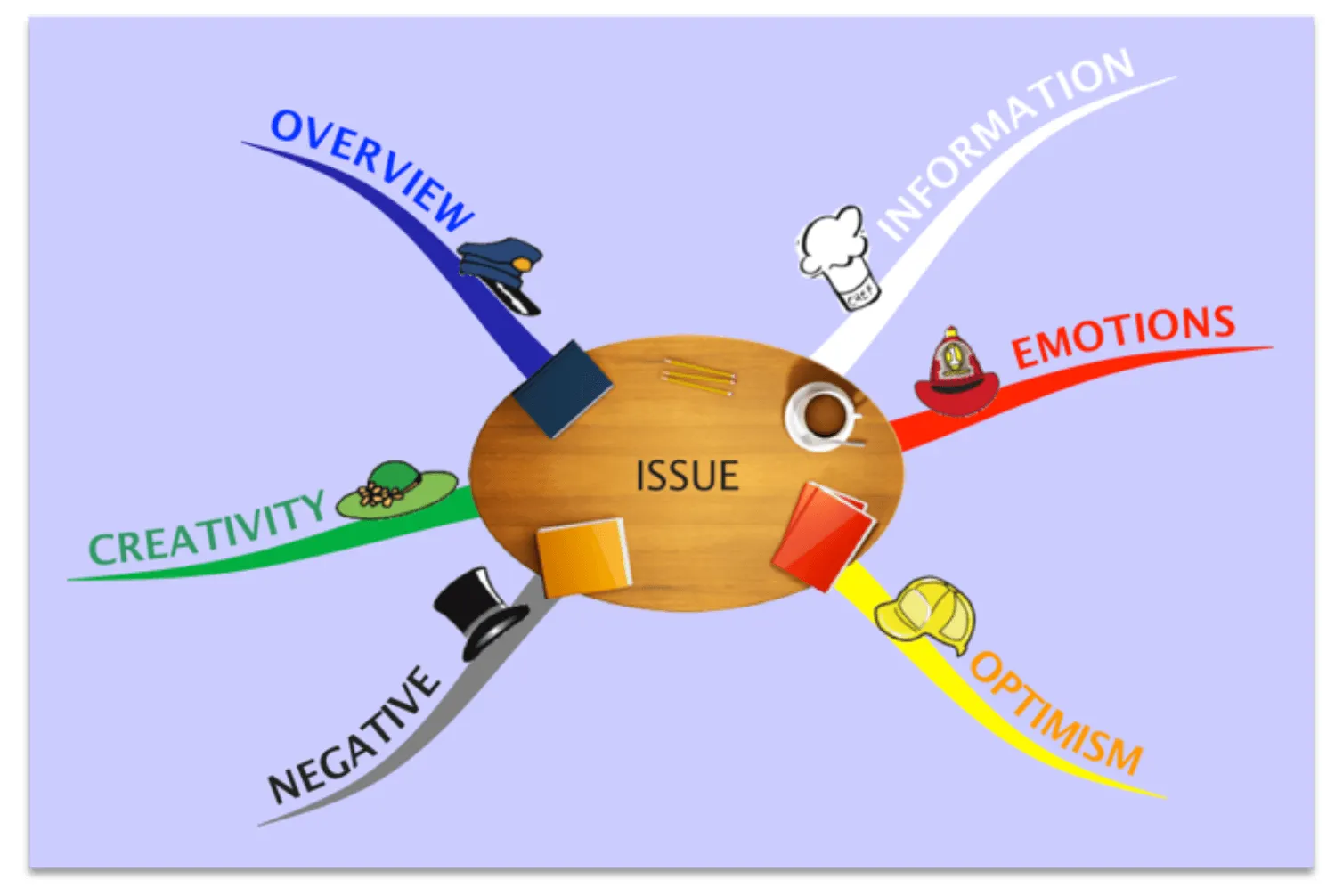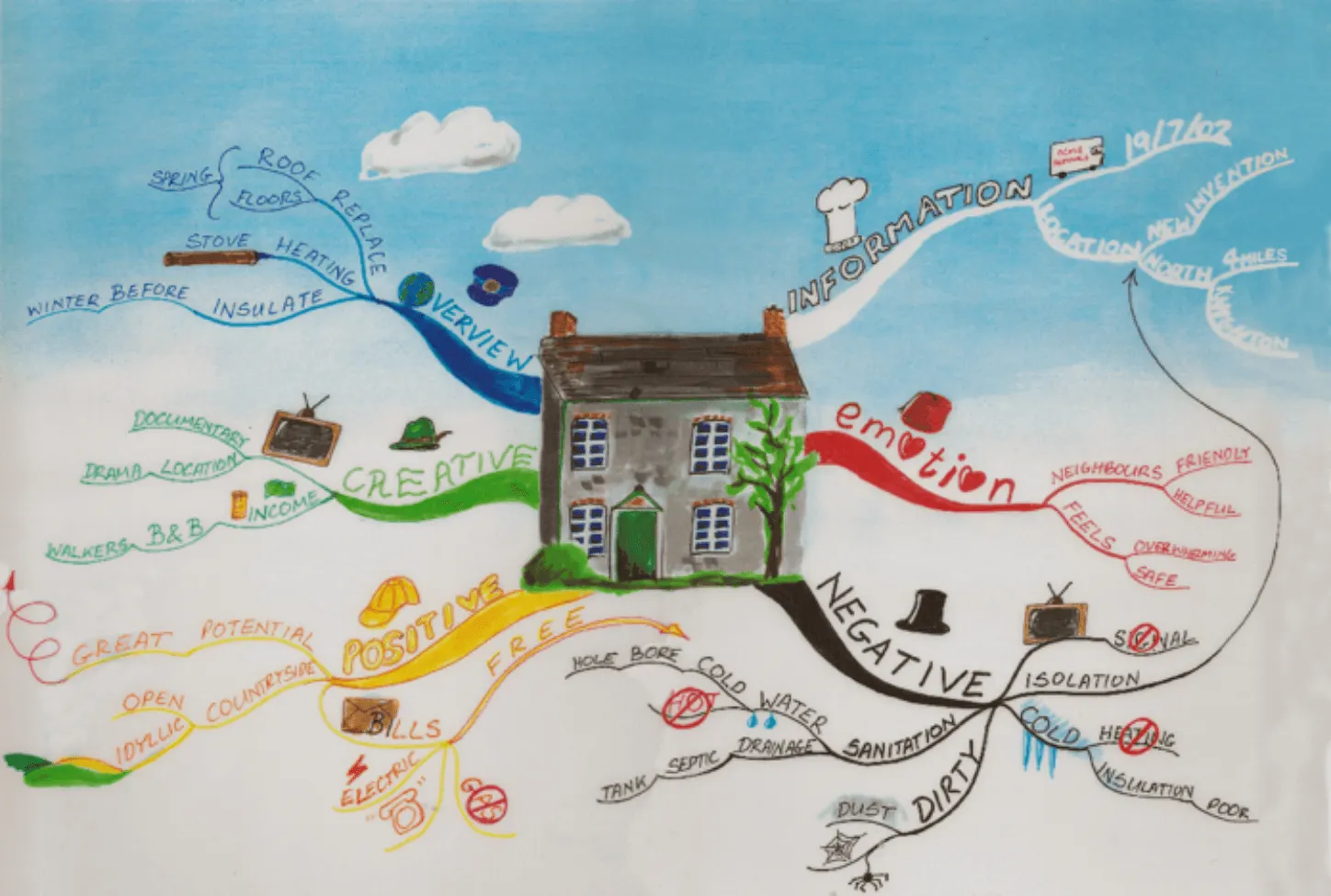Six Thinking Hats Mind Maps
Mind Mapping improves clarity and efficiency of thinking. As it is a ‘generative’ process it naturally creates and captures more ideas. One of the benefits of this is you can combine other thinking tools with Mind Mapping. The synergy of the two brings greater benefit than using either in isolation. There are many instances of this but in this post I’d like to talk about blending Mind Maps and Edward DeBono’s Six Thinking Hats.
The Issue with Traditional Meetings

Six Thinking Hats separates out thinking into distinct types. “Why is this useful?” I hear you ask. Imagine a meeting to discuss a new strategy to solve a problem. There will be different characters and opinions in the room. If you have someone who is particularly forceful, extrovert or senior their opinion might win through despite the fact a more introverted individual could have justified, useful but contradictory ideas. Situations may arise where one person is reacting emotionally while another person is trying to be objective. You could have one team member who is unrealistically optimistic. He is sure the solution will work and refuses to believe otherwise despite evidence to the contrary. There is another much more cautious individual who can see only potential pitfalls and drawbacks. This can lead to conflict. The optimist and pessimist constantly returning to the same points over and over to try and convince the others their point of view is correct. This wastes time and is counter-productive.
The Process

Each hat represents a particular mode of thinking. The person chairing the meeting begins wearing the metaphorical organising “Blue Hat”. He outlines the situation, defines the problem and seeks agreement on terms of reference.
He then asks attendees to wear their metaphorical “White Hat”. This represents information and facts. Everyone is encouraged to contribute so no one has the opportunity to monopolise discussion. Team members are only allowed to present factual information that can be verified. They’re not allowed to express opinions at this stage. Any discussion is kept neutral and objective. It is also an opportunity to identify any missing information which may need to be investigated. It is important to begin with as much relevant information on the table as possible. Once the facts have been recorded the meeting moves on to the next ‘hat’.
Typically, everyone next puts on their ‘Green Hat’. The focus is on creative possibilities, alternatives and new ideas. Lateral thinking is encouraged and once again everyone should contribute. If time allows, this could be an opportunity to create a separate, rapid Mind Map brainstorm. (More on how in a later post.)
The fourth hat is ‘Red’. It seeks intuitive or instinctive gut reactions or emotional feelings. No justification is needed. The red hat is limited to a very short 30 seconds or so to ensure that it is informative but not a primary form of judgement. Tony Buzan referred to gut feel as ‘super-logic’. Intuition is the result of a lot of processing in the brain. Research suggests that the brain is constantly comparing sensory information and current experiences against memories of previous events to predict what will happen next. This process happens automatically and subconsciously. Intuition occurs when your brain has made a significant match or mismatch, but this has not yet reached your conscious awareness. Scientific breakthroughs may start with an intuitive leap that is later tested and validated through rigorous testing and analysis.
Next comes “Yellow”. This is where the optimist gets to have their say and everyone else is also only allowed to contribute benefits, values and harmony. Yellow hat is joyous and motivational but it is important not to get too carried away.
Yellow must be balanced by “Black”. It is important to identify potential pitfalls, dangers and reasons to be cautious or conservative. Once again, there is no time-wasting confrontation as everyone is wearing the same black hat. Analogous to the situation with yellow, do not dwell too much on black as there is a danger to kill positivity.
The person chairing the meeting returns at the end to wearing the “Blue Hat” to summarise and draw conclusions.
The sequence of hats may differ depending on the situation or application but always begins and ends with blue. Each hat is used for a few minutes at a time only, to avoid ‘paralysis by analysis’.
So where does Mind Mapping come in?

If a colour coded Mind Map with a branch for each hat is created and displayed during the meeting it acts not just as a record but a reminder of what has been covered. Everyone can be satisfied that their voice has been heard. It is far easier to develop ideas because when everyone is working on a specific hat their thinking is in the context of everything else that has been discussed previously. A Black idea can be triggered by a yellow one without conflict and red feelings can be placed in the context of information. Tony Buzan loved ‘Star Trek’. In his honour the process could be likened to a collaborative group ‘Mind Meld’.
The benefits are not just for group collaboration. A Six Hat Mind Map makes a very effective self-audit. It ensures you have covered all the angles in a situation rather than getting carried away by your enthusiasm or caution and worry. Of course, there is less danger of arguing with yourself so you do not have to stick rigidly to the sequence of hats. Just add ideas to the appropriate branch as they occur to you. If you suddenly get a feeling while in green hat mode, just add it to the red branch. Using a Mind Map lets you see connections and associations so you may find yourself, for example, drawing arrows between the yellow branch and the black. Thus, showing how a downside can be approached in such a way that it is transformed into a benefit or successfully defended against. (We will explore how this is done in a later post.)
It is great to see the combination of ideas from two titans of thinking – Buzan and DeBono – forming something really special.
